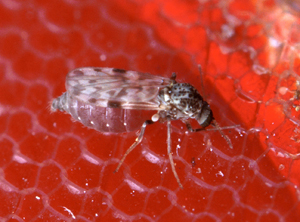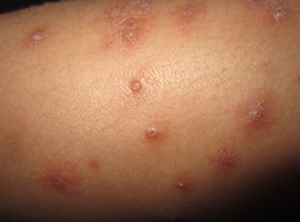What are no-see-ums?
 Biting midges, or “no-see-ums,” are winged insects from the Ceratopogonidae family, which includes over 4,000 species. They are tiny gnat-like insects (only 1-3 mm long) and, like black flies, inflict painful bites.
Biting midges, or “no-see-ums,” are winged insects from the Ceratopogonidae family, which includes over 4,000 species. They are tiny gnat-like insects (only 1-3 mm long) and, like black flies, inflict painful bites.
Biting midges can be a nuisance to campers, fishermen, hunters, hikers, gardeners, and others who spend time outdoors during early morning and evenings, and even during the daytime on still, cloudy days. They readily bite humans, but they are so small that they may look like black lint or some flecks of dirt. Consequently, the person being bitten often cannot see what is doing the biting — hence the name “no-see-ums!”
Biting midges are sometimes incorrectly referred to as “sand flies.” Sand flies are insects that belong to a different biological group and should not be confused with biting midges. Interestingly, both male and female biting midges feed on nectar; however, only the females feed on blood, which is needed for the maturation of fertilized eggs. The Culicoides genus, in particular, is known to occasionally feed on animals and humans and acts as a possible vector in the transmission of diseases such as Oropouche fever, filariasis, and Japanese encephalitis, though disease transmission to humans in North America is extremely rare.
The distribution of biting midges in the genus Culicoides is world-wide; 47 species are known to occur in Florida alone! Species belonging to the genus Leptoconops occur in the tropics, sub-tropics, the Caribbean, and some coastal areas of southeast Florida. They are often found in or around environments characterized by mud or moist soil around streams, ponds, and marshes. They fly only in the warm months of the year and are most active before and during dusk.
 Bites can lead to severely itchy bumps or hives, which are the most common lesions observed with biting midge attacks. Because “no-see-um” bites may occur without known (or even suspected) contact with Culicoides, it is important to remember several clues that may help make the diagnosis of a biting midge-induced rash. First, bumps are usually found only in areas of exposed skin on the legs or forearms; such lesions tend to end abruptly at areas normally protected by clothing. Second, family members or friends may have similar lesions, usually acquired within the same time period. Third, recent travel history to areas where “no-see-ums” are known to be active can often be elicited if the time is taken to inquire.
Bites can lead to severely itchy bumps or hives, which are the most common lesions observed with biting midge attacks. Because “no-see-um” bites may occur without known (or even suspected) contact with Culicoides, it is important to remember several clues that may help make the diagnosis of a biting midge-induced rash. First, bumps are usually found only in areas of exposed skin on the legs or forearms; such lesions tend to end abruptly at areas normally protected by clothing. Second, family members or friends may have similar lesions, usually acquired within the same time period. Third, recent travel history to areas where “no-see-ums” are known to be active can often be elicited if the time is taken to inquire.
Although the skin bite reactions are temporary, biting midge lesions often require several weeks for complete resolution to occur. Lesions can be extremely itchy and can lead to intense scratching. First aid management includes oral antihistamines and topical steroids to relieve itching and inflammation. In addition, the threshold for starting oral antibiotics should be low given the risk of bacterial super-infection secondary to scratching.
Leave a Comment